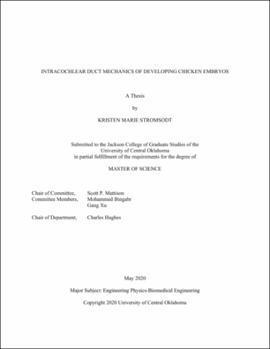| dc.contributor.author | Stromsodt, Kristen Marie | |
| dc.date.accessioned | 2021-07-07T16:59:29Z | |
| dc.date.available | 2021-07-07T16:59:29Z | |
| dc.date.issued | 2020 | |
| dc.identifier.uri | https://hdl.handle.net/11244/330129 | |
| dc.description.abstract | The cochlea is a small, coiled part of the inner ear responsible for the transduction of mechanical sound pressure into electrical stimulation in the brain. Despite the importance of the cochlea for normal hearing, the complex mechanical interactions between active and passive components are not well understood. By utilizing a technique known as optical coherence vibrometry, we performed initial quantification of the changes in mechanical motion of the embryonic avian cochlear duct. By quantifying changes in the mechanical response of the cochlea to sound, as key regions of the cochlea develop, we hope to determine the passive role each of these components play in healthy hearing. To quantify the mechanical motion of the cochlea, we exposed the cochlea to pure tone auditory stimuli at various sound pressure levels and frequencies. We recorded the amplitude and phase of the mechanical response of key structures in the cochlea and compared them across developmental stages. | en_US |
| dc.rights | All rights reserved by the author, who has granted UCO Chambers Library the non-exclusive right to share this material in its online repositories. Contact UCO Chambers Library's Digital Initiatives Working Group at diwg@uco.edu for the permission policy on the use, reproduction or distribution of this material. | |
| dc.title | Intracochlear duct mechanics of developing chicken embryos | en_US |
